South Carolina’s enchanting landscapes, spanning from its sun-kissed coastlines to its verdant uplands, harbor a fascinating array of hawks. Known for their remarkable flight abilities and hunting acumen, these South Carolina birds of prey are a sight to behold for any birdwatcher or wildlife enthusiast.
Types of Hawk in South Carolina
Red-tailed Hawks – These majestic hawks can be observed in various habitats, including open fields, woodlands, and along highways. Look for them at Huntington Beach State Park, Francis Marion National Forest, and Congaree National Park.
Red-shouldered Hawks – These medium-sized hawks prefer wetland habitats and can often be spotted near rivers and swamps. Visit the ACE Basin National Wildlife Refuge or the Waccamaw National Wildlife Refuge for a chance to see them.
Cooper’s Hawks – Cooper’s Hawks can be found in both urban and rural areas of South Carolina. These agile hunters are often seen near bird feeders and wooded neighborhoods. Keep an eye out for them at Congaree National Park and Lake Murray.
Northern Harriers – The Northern Harrier is a rare but notable visitor to South Carolina. They can be seen in coastal marshes and wetlands, as well as open grasslands. Head to the Savannah National Wildlife Refuge or Santee Coastal Reserve to catch a glimpse of these low-flying raptors.
Sharp-shinned Hawks – Sharp-shinned Hawks are small, swift hunters found in South Carolina. They prefer wooded areas, especially forests with dense undergrowth. Look for them in the Francis Beidler Forest and the Harbison State Forest.
Broad-winged Hawks – Broad-winged Hawks are migratory birds that pass through South Carolina during their spring and fall migrations. They can be seen in large numbers during their soaring flights, known as “kettles,” as they head to their breeding or wintering grounds. Visit Caesar’s Head State Park or Table Rock State Park to witness these impressive migrations.
South Carolina Hawks Photo Guide
Red-tailed Hawk (Buteo jamaicensis)

The Red-tailed Hawk is a large bird of prey that is commonly found across North America. This species is part of the genus Buteo, which is often referred to as the “true hawks,” and includes more than two dozen species of raptors.
Red-tailed Hawks have a robust size, ranging from 18 to 26 inches in length and sporting a wingspan that can exceed 4 feet. They have a broad, rounded set of wings and a short, wide red tail. This species is most easily recognized by its rich, rust-colored tail, which gives it its common name. However, juvenile hawks might not yet have this distinctive feature.
Their feathers are generally dark brown on their dorsal side (back) with a lighter, often speckled, ventral side (front). The intensity and pattern of their plumage can vary significantly based on their age and geographic location, as there are about 14 recognized subspecies of Red-tailed Hawks.
As for their diet, Red-tailed Hawks are carnivores and have a broad diet that includes rodents, ground rabbits, reptiles, and other birds. They are skilled hunters that typically sit on high perches and use their keen eyesight to spot potential prey. Once they have identified a target, they swoop down to capture it with their powerful talons.
Red-tailed Hawks mate for life and build nests high off the ground, often in tall trees or on cliff edges. Their nests are made of sticks and can be quite large. They typically lay 1-3 eggs per year, which are incubated by both parents.
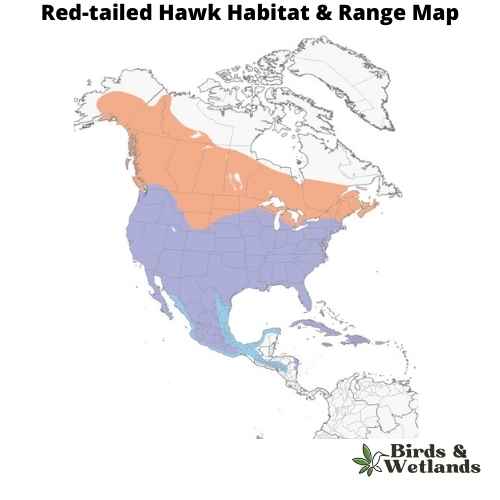
Red-tailed Hawk Sound
Red-shouldered Hawk (Buteo lineatus)

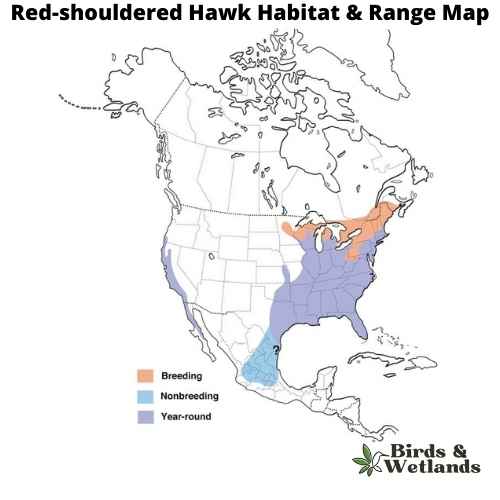
Listen:
The red-shouldered hawk are medium sized birds of prey, part of the buteo hawks family. It can be distinguished from other hawks by its reddish iris and pale legs.
The adult has rusty red upperparts, white underparts, a black chin and throat, and a reddish brown stripe over each eye, reddish brown heads and a strongly banded tail. The tail is reddish brown with two paler bands across it and they have white checkered wings. Juveniles are brown with dark barring and have pale fringes on the feathers of their wings.
Red-shouldered hawks nest in trees, though they also inhabit manmade structures including barns, bridges, and buildings. They prefer wooded areas with an open canopy but will use other places as well for nesting such as shrubs and hedges if needed.
The red-shouldered hawk’s diet – they eat small mammals such as ground squirrels, rabbits, voles, mice and rats. They also eat birds such as quail, pigeons and doves; reptiles including snakes; amphibians; fish; crustaceans; insects; and carrion (dead animals).
Cooper’s Hawk (Accipiter cooperii)

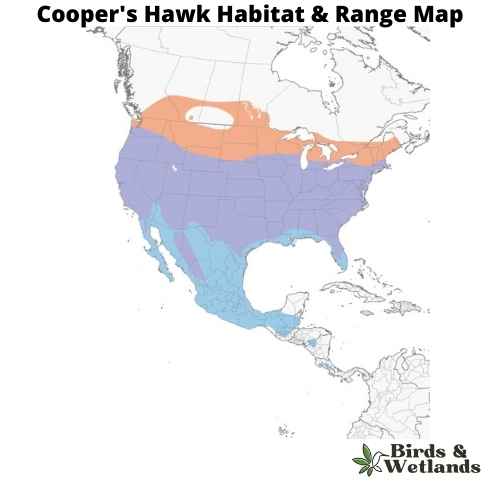
Listen:
The Cooper’s Hawk is a medium-sized bird of prey native to North America. Known for its agility and speed, it is part of the Accipitridae hawk species, which also includes other hawks, eagles, and kites.
Cooper’s Hawks are typically about 14 to 20 inches in length, with a wingspan ranging from 27 to 36 inches. They are known for their distinctive long, rounded tails and short, rounded wings. They have a steely blue gray top, with rusty bars on their underparts and thick, dark bands on their tails.
The Cooper’s Hawk is a skilled predator, primarily hunting birds and small mammals. They are adept at hunting in both dense forests and open areas, often catching prey mid-air in high-speed pursuits. They have also been known to visit the backyard bird feeder, not for the seed, but to prey on the smaller birds that gather there.
Cooper’s Hawks often build nests in dense tree canopies where they are well concealed. The female usually lays 3 to 5 eggs, and both parents share incubation duties. The young hawks fledge after about a month but will stay close to the nest, relying on their parents for food as they learn to hunt.
Northern Harrier (Circus hudsonius)

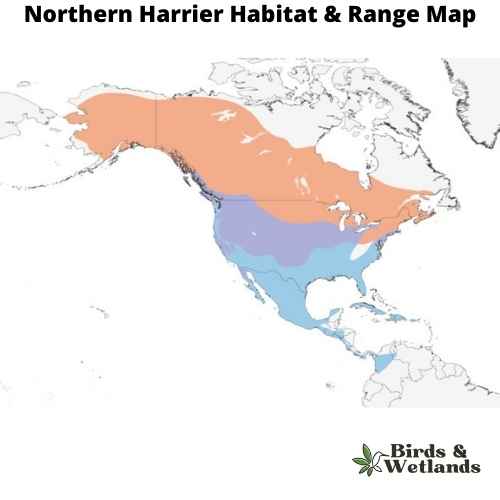
Listen:
The Northern Harrier is a medium-sized, slender hawk.
Adult birds are gray above, with pale bars on the wing feathers and white markings on the underwings and a white rump patch. The breast is barred with black and white, and the belly is streaked with brown.
They prefer open areas, such as grasslands and marshes, but can be found in almost any open habitat except dense woods.
Northern Harriers are opportunistic hunters that feed on small mammals such as mice, voles and rabbits as well as birds including quail, grouse and ducks. They hunt by flying low over open spaces such as fields or marshes.
Northern harrier nests on the ground in lowlands or hillsides near water bodies. It lays two to four eggs which hatch after 24 days of incubation by both parents. The chicks fledge after 30 days of hatching and remain dependent on their parents for another three weeks during which they learn how to fly.
Sharp-shinned Hawk (Accipiter striatus)

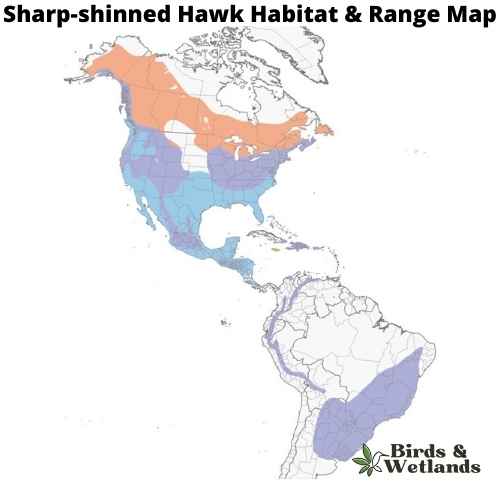
Listen:
The adult bird is brown on top and white underneath, with a dark brown band across its chest. It has short, rounded wings and a long tail that makes it look larger than it actually is. Adult sharp shinned hawks have black eyes, which are surrounded by white feathers. The female Sharp-shinned Hawk is browner than the male, who has darker brown markings on his back.
Sharp-shinned Hawks prefer open country for their habitat, including fields and meadows where they can hunt for mice and other small animals. They can be found throughout the United States but are most common in the east.
Sharp-shinned Hawks eat mostly small birds, such as sparrows and warblers, as well as small mammals such as mice and gophers. They catch prey by surprise using their incredible speed and agility, diving out of the sky at speeds up to 200 mph.
Sharp-shinned Hawks have an unusual hunting style for hawks—they prefer to catch their prey from perches above trees or telephone wires, rather than swooping down from above like most other hawks do and can often be seen hunting near bird feeders.
Broad-winged Hawk (Buteo platypterus)

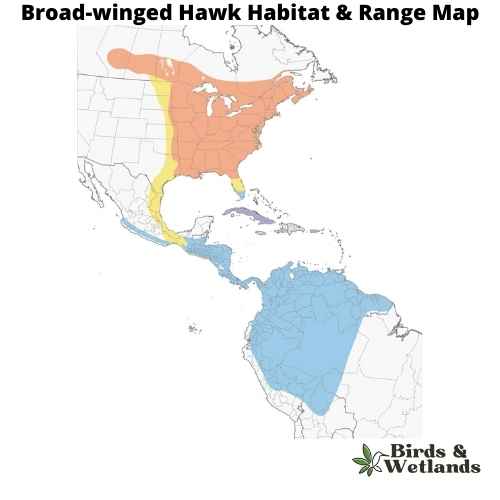
Broad-winged Hawk Sound
The Broad-winged Hawk holds a commanding presence as one of the largest hawks in the world, known for its broad wings. Its formidable size is a testament to its prowess as a bird of prey, effortlessly navigating the open skies in search of food.
Their distinctive appearance sets them apart. The adults exhibit a striking black and white pattern, complemented by a rusty breast and buff underparts and brown wings. In contrast, juveniles are adorned with a brown plumage, marked by pale edges on their feathers, adding to their distinctive youthful charm.
These hawks are most commonly found in open areas, such as farmlands or grasslands interspersed with scattered trees, which provide optimal conditions for when hawks hunt.
When it comes to their diet, Broad-winged Hawks feed on small rodents like mice, rats, squirrels, rabbits, and voles. Broad winged hawks breed during the spring and summer months then migrate to central and south America.
Where to Spot Hawks in South Carolina
Congaree National Park: As South Carolina’s only national park, Congaree provides essential habitat for a diverse range of hawk species. Visitors can explore the park’s floodplain forest and spot hawks soaring above.
Caesars Head State Park: This state park offers a Hawk Watch program every fall where thousands of hawks can be seen migrating. The park’s rugged mountain landscape also provides ample opportunities for birdwatching year-round especially great in breeding season.
Hunting Island State Park: Hunting Island’s unique coastal location and lighthouse views provide an excellent platform for viewing migrating hawks.
Hawk Ridge Bird Observatory: Located in the Blue Ridge Mountains, this observatory offers guided hawk watches and environmental education programs.
South Carolina is an ideal location for hawk-watchers, with a variety of locations offering diverse habitats. Continuing your birdwatching adventures in neighboring states, each with their unique set of hawk species and watching spots, can add even more to your experience.
| Neighbouring State’s Hawks | Hawk Watching Site |
|---|---|
| Hawk Species in North Carolina | Mahogany Rock Overlook |
| Hawk Species in Georgia | Amicalola Falls State Park |


